Smoking Cessation: Investigating Age and Gender Effects on Quitting
VerifiedAdded on 2023/01/10
|18
|2816
|23
Report
AI Summary
This report presents a literature review proposal for a dissertation examining the impact of gender and age on smoking cessation. It covers the public health issue of smoking, analyzing its relationship with individual demographics. The report includes six chapters: an introduction, background on smoking, research methodology, results from SPSS analysis of smoking data, findings and discussion, critical evaluation, and conclusions with policy recommendations. The methodology involves primary research using questionnaires administered to 55 respondents. The results section presents frequency distributions and cross-tabulations to analyze the data. Despite the initial hypothesis, the study found no significant association between gender, age, and the desire to quit smoking, although some trends emerged related to lifestyle and income. The report concludes with a critical evaluation of the research methods and suggests areas for future investigation.

CW3
Paraphrase This Document
Need a fresh take? Get an instant paraphrase of this document with our AI Paraphraser
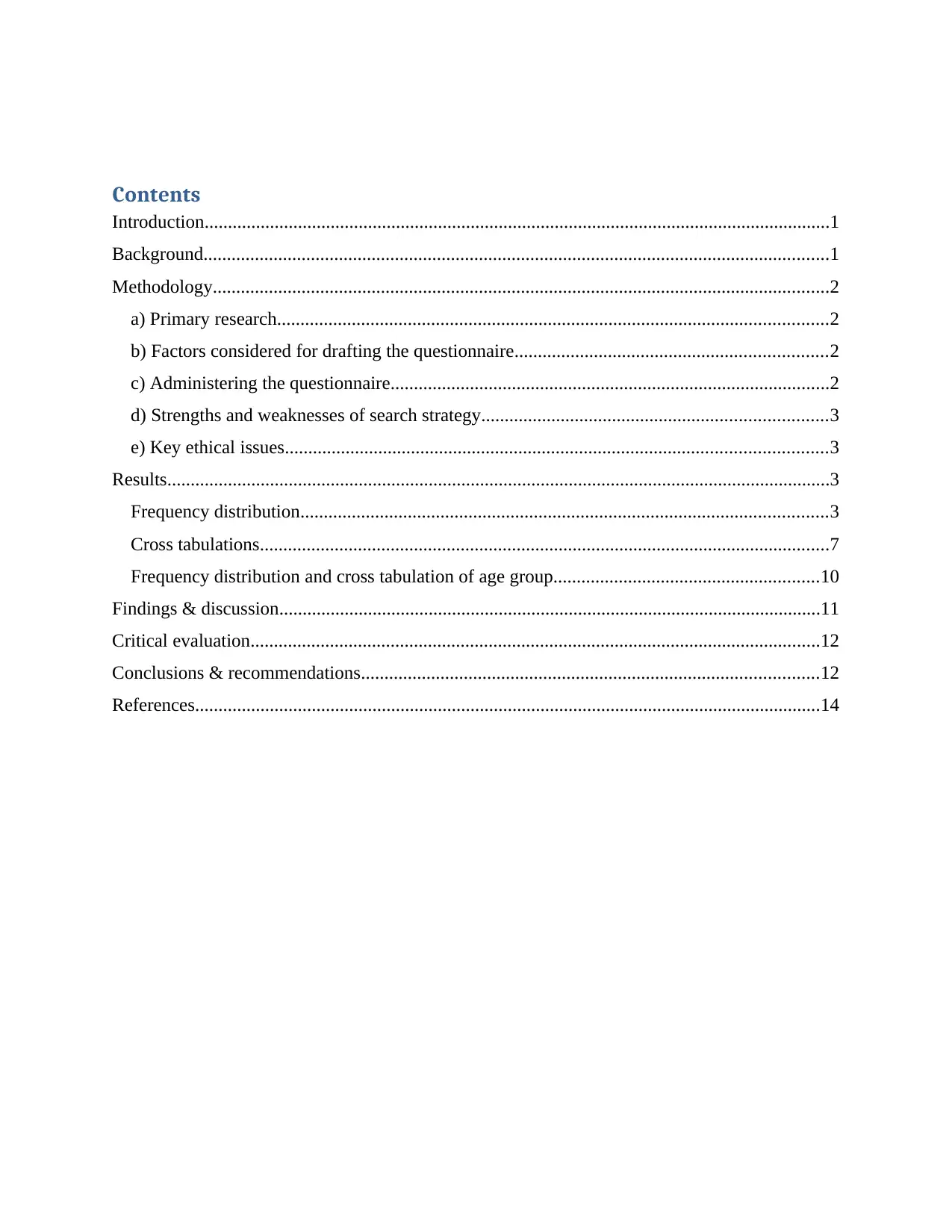
Contents
Introduction......................................................................................................................................1
Background......................................................................................................................................1
Methodology....................................................................................................................................2
a) Primary research......................................................................................................................2
b) Factors considered for drafting the questionnaire...................................................................2
c) Administering the questionnaire..............................................................................................2
d) Strengths and weaknesses of search strategy..........................................................................3
e) Key ethical issues....................................................................................................................3
Results..............................................................................................................................................3
Frequency distribution.................................................................................................................3
Cross tabulations..........................................................................................................................7
Frequency distribution and cross tabulation of age group.........................................................10
Findings & discussion....................................................................................................................11
Critical evaluation..........................................................................................................................12
Conclusions & recommendations..................................................................................................12
References......................................................................................................................................14
Introduction......................................................................................................................................1
Background......................................................................................................................................1
Methodology....................................................................................................................................2
a) Primary research......................................................................................................................2
b) Factors considered for drafting the questionnaire...................................................................2
c) Administering the questionnaire..............................................................................................2
d) Strengths and weaknesses of search strategy..........................................................................3
e) Key ethical issues....................................................................................................................3
Results..............................................................................................................................................3
Frequency distribution.................................................................................................................3
Cross tabulations..........................................................................................................................7
Frequency distribution and cross tabulation of age group.........................................................10
Findings & discussion....................................................................................................................11
Critical evaluation..........................................................................................................................12
Conclusions & recommendations..................................................................................................12
References......................................................................................................................................14

⊘ This is a preview!⊘
Do you want full access?
Subscribe today to unlock all pages.

Trusted by 1+ million students worldwide
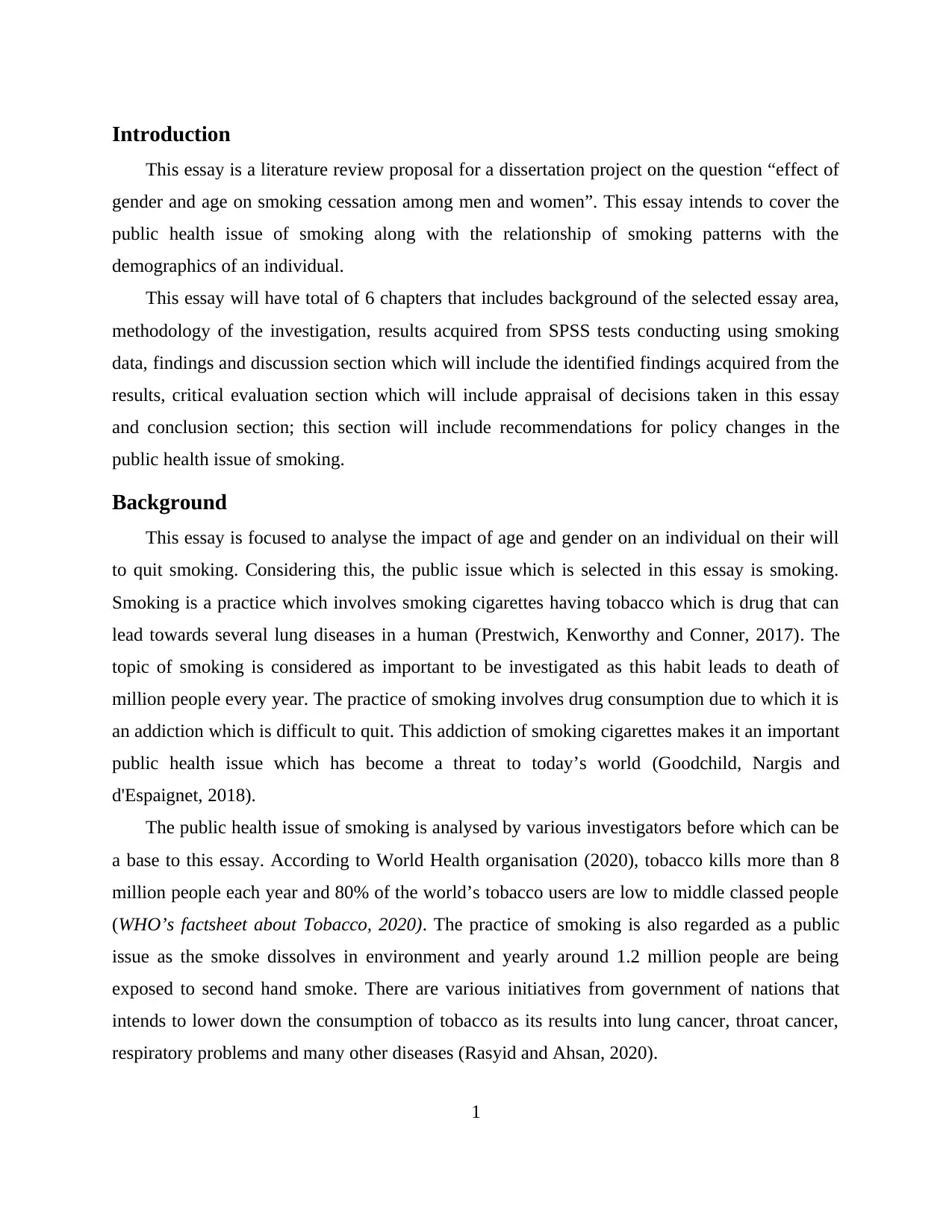
Introduction
This essay is a literature review proposal for a dissertation project on the question “effect of
gender and age on smoking cessation among men and women”. This essay intends to cover the
public health issue of smoking along with the relationship of smoking patterns with the
demographics of an individual.
This essay will have total of 6 chapters that includes background of the selected essay area,
methodology of the investigation, results acquired from SPSS tests conducting using smoking
data, findings and discussion section which will include the identified findings acquired from the
results, critical evaluation section which will include appraisal of decisions taken in this essay
and conclusion section; this section will include recommendations for policy changes in the
public health issue of smoking.
Background
This essay is focused to analyse the impact of age and gender on an individual on their will
to quit smoking. Considering this, the public issue which is selected in this essay is smoking.
Smoking is a practice which involves smoking cigarettes having tobacco which is drug that can
lead towards several lung diseases in a human (Prestwich, Kenworthy and Conner, 2017). The
topic of smoking is considered as important to be investigated as this habit leads to death of
million people every year. The practice of smoking involves drug consumption due to which it is
an addiction which is difficult to quit. This addiction of smoking cigarettes makes it an important
public health issue which has become a threat to today’s world (Goodchild, Nargis and
d'Espaignet, 2018).
The public health issue of smoking is analysed by various investigators before which can be
a base to this essay. According to World Health organisation (2020), tobacco kills more than 8
million people each year and 80% of the world’s tobacco users are low to middle classed people
(WHO’s factsheet about Tobacco, 2020). The practice of smoking is also regarded as a public
issue as the smoke dissolves in environment and yearly around 1.2 million people are being
exposed to second hand smoke. There are various initiatives from government of nations that
intends to lower down the consumption of tobacco as its results into lung cancer, throat cancer,
respiratory problems and many other diseases (Rasyid and Ahsan, 2020).
1
This essay is a literature review proposal for a dissertation project on the question “effect of
gender and age on smoking cessation among men and women”. This essay intends to cover the
public health issue of smoking along with the relationship of smoking patterns with the
demographics of an individual.
This essay will have total of 6 chapters that includes background of the selected essay area,
methodology of the investigation, results acquired from SPSS tests conducting using smoking
data, findings and discussion section which will include the identified findings acquired from the
results, critical evaluation section which will include appraisal of decisions taken in this essay
and conclusion section; this section will include recommendations for policy changes in the
public health issue of smoking.
Background
This essay is focused to analyse the impact of age and gender on an individual on their will
to quit smoking. Considering this, the public issue which is selected in this essay is smoking.
Smoking is a practice which involves smoking cigarettes having tobacco which is drug that can
lead towards several lung diseases in a human (Prestwich, Kenworthy and Conner, 2017). The
topic of smoking is considered as important to be investigated as this habit leads to death of
million people every year. The practice of smoking involves drug consumption due to which it is
an addiction which is difficult to quit. This addiction of smoking cigarettes makes it an important
public health issue which has become a threat to today’s world (Goodchild, Nargis and
d'Espaignet, 2018).
The public health issue of smoking is analysed by various investigators before which can be
a base to this essay. According to World Health organisation (2020), tobacco kills more than 8
million people each year and 80% of the world’s tobacco users are low to middle classed people
(WHO’s factsheet about Tobacco, 2020). The practice of smoking is also regarded as a public
issue as the smoke dissolves in environment and yearly around 1.2 million people are being
exposed to second hand smoke. There are various initiatives from government of nations that
intends to lower down the consumption of tobacco as its results into lung cancer, throat cancer,
respiratory problems and many other diseases (Rasyid and Ahsan, 2020).
1
Paraphrase This Document
Need a fresh take? Get an instant paraphrase of this document with our AI Paraphraser
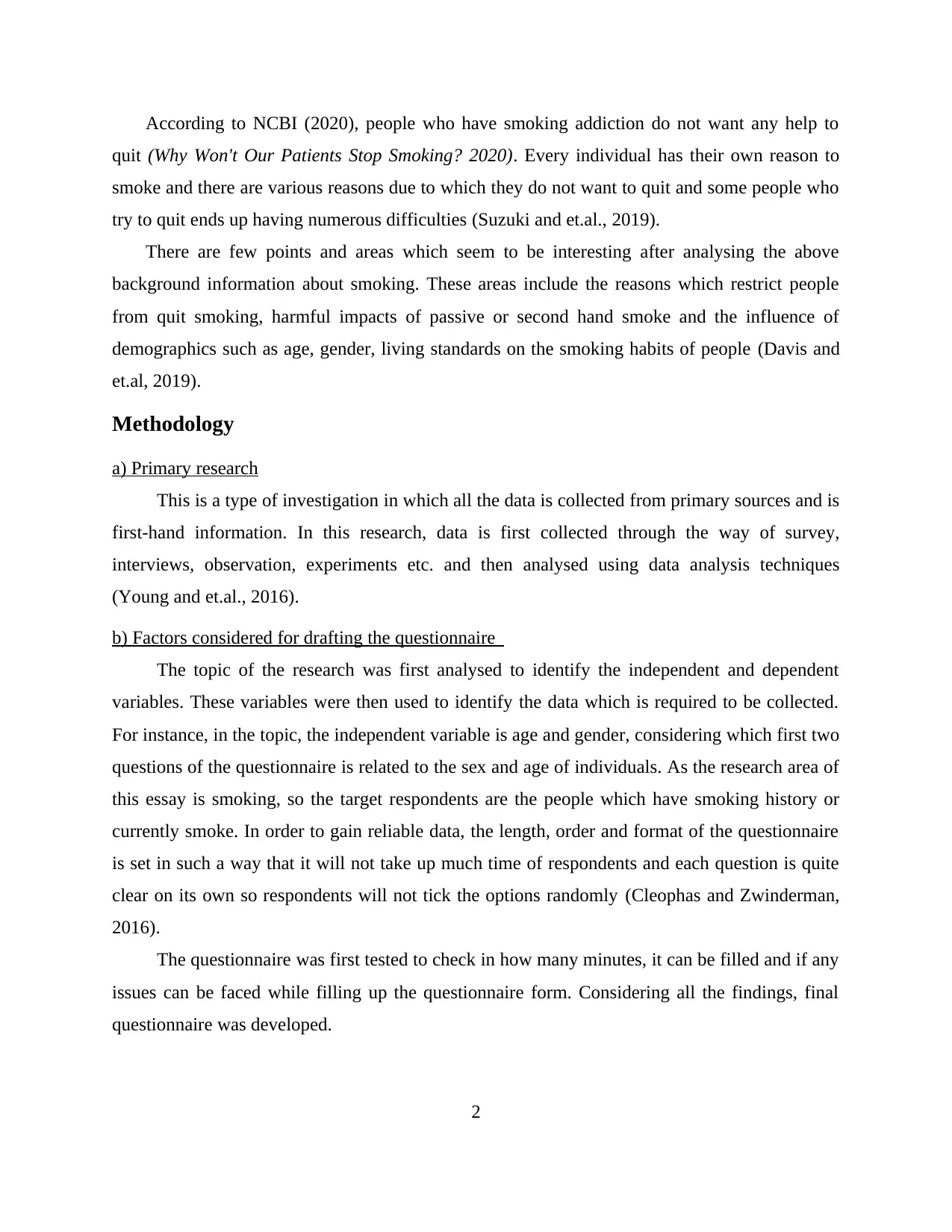
According to NCBI (2020), people who have smoking addiction do not want any help to
quit (Why Won't Our Patients Stop Smoking? 2020). Every individual has their own reason to
smoke and there are various reasons due to which they do not want to quit and some people who
try to quit ends up having numerous difficulties (Suzuki and et.al., 2019).
There are few points and areas which seem to be interesting after analysing the above
background information about smoking. These areas include the reasons which restrict people
from quit smoking, harmful impacts of passive or second hand smoke and the influence of
demographics such as age, gender, living standards on the smoking habits of people (Davis and
et.al, 2019).
Methodology
a) Primary research
This is a type of investigation in which all the data is collected from primary sources and is
first-hand information. In this research, data is first collected through the way of survey,
interviews, observation, experiments etc. and then analysed using data analysis techniques
(Young and et.al., 2016).
b) Factors considered for drafting the questionnaire
The topic of the research was first analysed to identify the independent and dependent
variables. These variables were then used to identify the data which is required to be collected.
For instance, in the topic, the independent variable is age and gender, considering which first two
questions of the questionnaire is related to the sex and age of individuals. As the research area of
this essay is smoking, so the target respondents are the people which have smoking history or
currently smoke. In order to gain reliable data, the length, order and format of the questionnaire
is set in such a way that it will not take up much time of respondents and each question is quite
clear on its own so respondents will not tick the options randomly (Cleophas and Zwinderman,
2016).
The questionnaire was first tested to check in how many minutes, it can be filled and if any
issues can be faced while filling up the questionnaire form. Considering all the findings, final
questionnaire was developed.
2
quit (Why Won't Our Patients Stop Smoking? 2020). Every individual has their own reason to
smoke and there are various reasons due to which they do not want to quit and some people who
try to quit ends up having numerous difficulties (Suzuki and et.al., 2019).
There are few points and areas which seem to be interesting after analysing the above
background information about smoking. These areas include the reasons which restrict people
from quit smoking, harmful impacts of passive or second hand smoke and the influence of
demographics such as age, gender, living standards on the smoking habits of people (Davis and
et.al, 2019).
Methodology
a) Primary research
This is a type of investigation in which all the data is collected from primary sources and is
first-hand information. In this research, data is first collected through the way of survey,
interviews, observation, experiments etc. and then analysed using data analysis techniques
(Young and et.al., 2016).
b) Factors considered for drafting the questionnaire
The topic of the research was first analysed to identify the independent and dependent
variables. These variables were then used to identify the data which is required to be collected.
For instance, in the topic, the independent variable is age and gender, considering which first two
questions of the questionnaire is related to the sex and age of individuals. As the research area of
this essay is smoking, so the target respondents are the people which have smoking history or
currently smoke. In order to gain reliable data, the length, order and format of the questionnaire
is set in such a way that it will not take up much time of respondents and each question is quite
clear on its own so respondents will not tick the options randomly (Cleophas and Zwinderman,
2016).
The questionnaire was first tested to check in how many minutes, it can be filled and if any
issues can be faced while filling up the questionnaire form. Considering all the findings, final
questionnaire was developed.
2
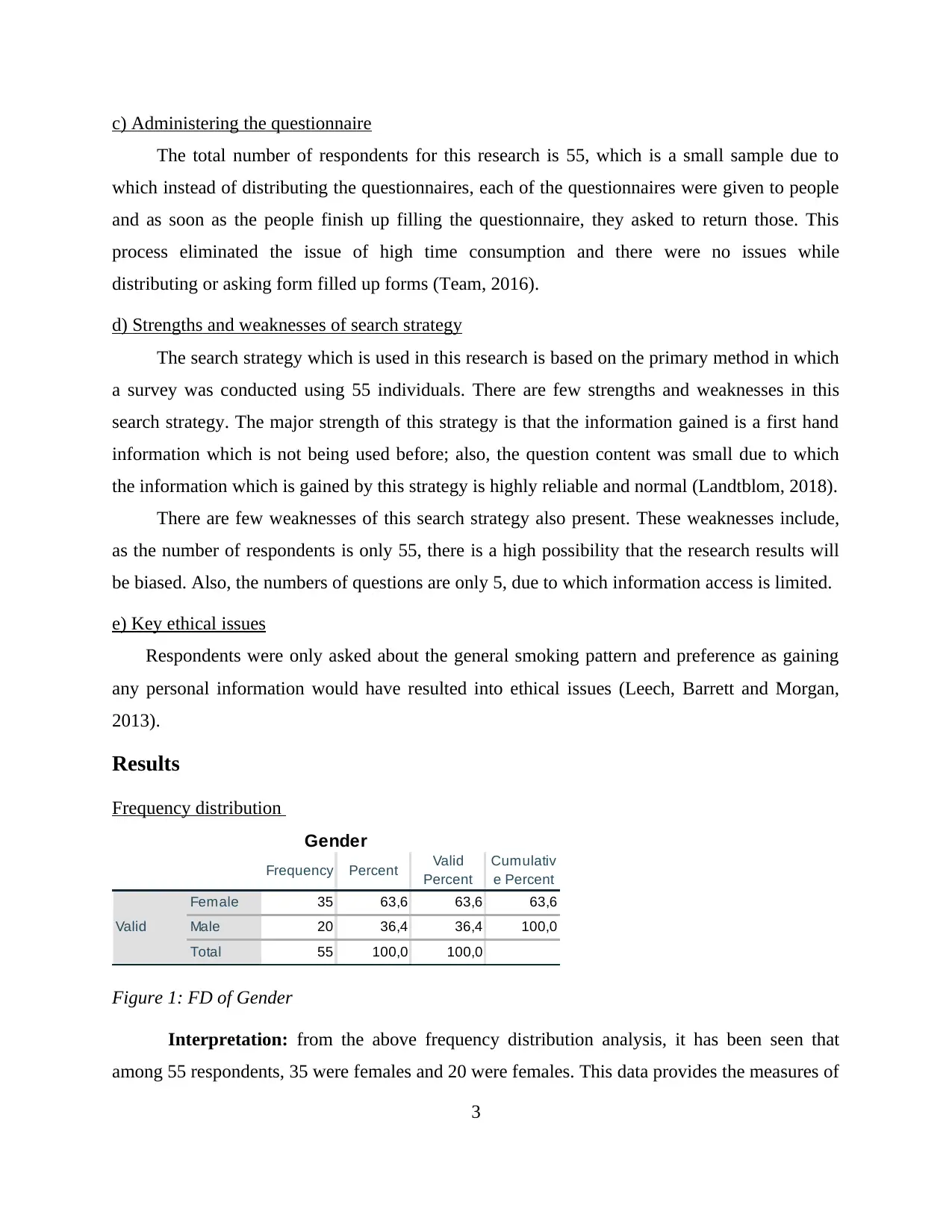
c) Administering the questionnaire
The total number of respondents for this research is 55, which is a small sample due to
which instead of distributing the questionnaires, each of the questionnaires were given to people
and as soon as the people finish up filling the questionnaire, they asked to return those. This
process eliminated the issue of high time consumption and there were no issues while
distributing or asking form filled up forms (Team, 2016).
d) Strengths and weaknesses of search strategy
The search strategy which is used in this research is based on the primary method in which
a survey was conducted using 55 individuals. There are few strengths and weaknesses in this
search strategy. The major strength of this strategy is that the information gained is a first hand
information which is not being used before; also, the question content was small due to which
the information which is gained by this strategy is highly reliable and normal (Landtblom, 2018).
There are few weaknesses of this search strategy also present. These weaknesses include,
as the number of respondents is only 55, there is a high possibility that the research results will
be biased. Also, the numbers of questions are only 5, due to which information access is limited.
e) Key ethical issues
Respondents were only asked about the general smoking pattern and preference as gaining
any personal information would have resulted into ethical issues (Leech, Barrett and Morgan,
2013).
Results
Frequency distribution
Frequency Percent Valid
Percent
Cumulativ
e Percent
Female 35 63,6 63,6 63,6
Male 20 36,4 36,4 100,0
Total 55 100,0 100,0
Gender
Valid
Figure 1: FD of Gender
Interpretation: from the above frequency distribution analysis, it has been seen that
among 55 respondents, 35 were females and 20 were females. This data provides the measures of
3
The total number of respondents for this research is 55, which is a small sample due to
which instead of distributing the questionnaires, each of the questionnaires were given to people
and as soon as the people finish up filling the questionnaire, they asked to return those. This
process eliminated the issue of high time consumption and there were no issues while
distributing or asking form filled up forms (Team, 2016).
d) Strengths and weaknesses of search strategy
The search strategy which is used in this research is based on the primary method in which
a survey was conducted using 55 individuals. There are few strengths and weaknesses in this
search strategy. The major strength of this strategy is that the information gained is a first hand
information which is not being used before; also, the question content was small due to which
the information which is gained by this strategy is highly reliable and normal (Landtblom, 2018).
There are few weaknesses of this search strategy also present. These weaknesses include,
as the number of respondents is only 55, there is a high possibility that the research results will
be biased. Also, the numbers of questions are only 5, due to which information access is limited.
e) Key ethical issues
Respondents were only asked about the general smoking pattern and preference as gaining
any personal information would have resulted into ethical issues (Leech, Barrett and Morgan,
2013).
Results
Frequency distribution
Frequency Percent Valid
Percent
Cumulativ
e Percent
Female 35 63,6 63,6 63,6
Male 20 36,4 36,4 100,0
Total 55 100,0 100,0
Gender
Valid
Figure 1: FD of Gender
Interpretation: from the above frequency distribution analysis, it has been seen that
among 55 respondents, 35 were females and 20 were females. This data provides the measures of
3
⊘ This is a preview!⊘
Do you want full access?
Subscribe today to unlock all pages.

Trusted by 1+ million students worldwide
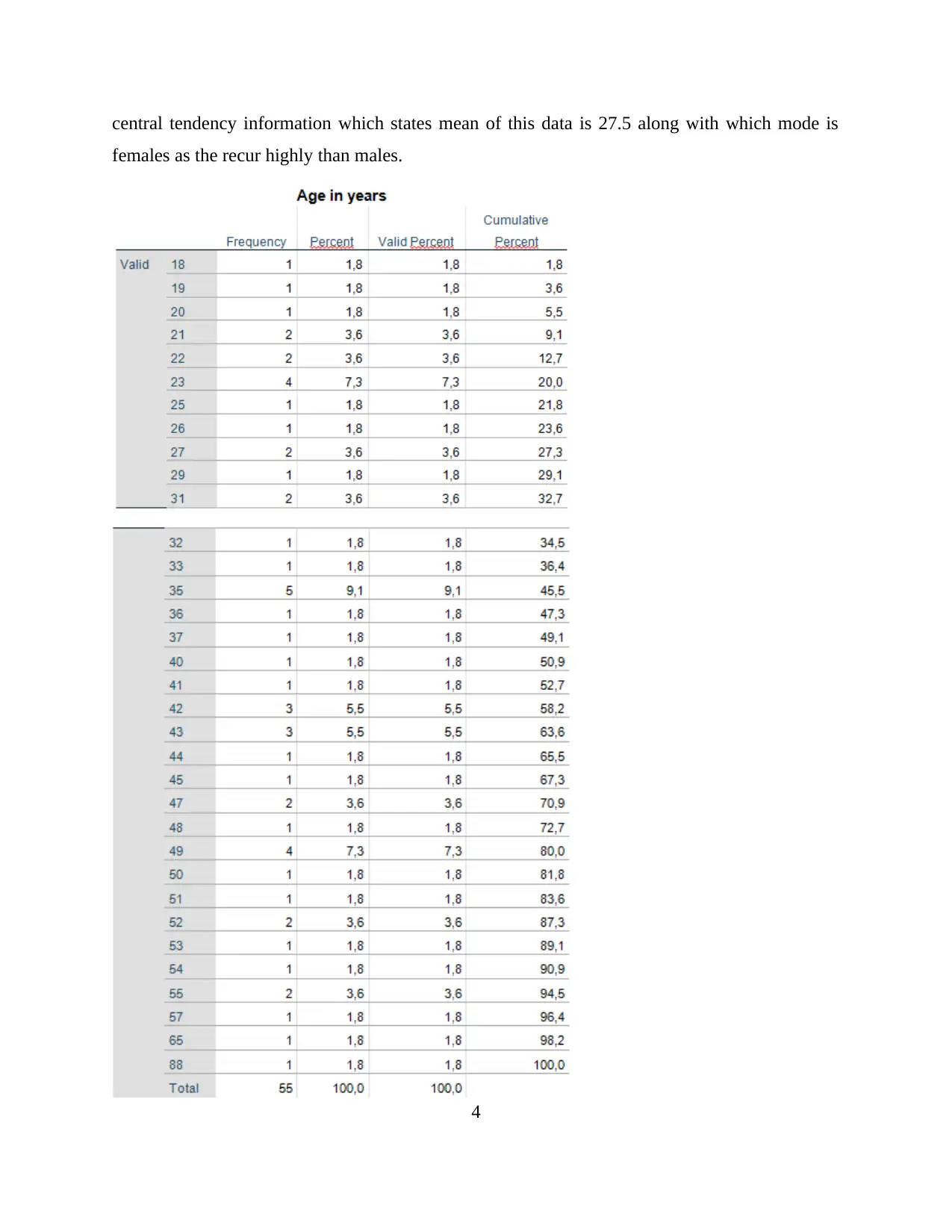
central tendency information which states mean of this data is 27.5 along with which mode is
females as the recur highly than males.
4
females as the recur highly than males.
4
Paraphrase This Document
Need a fresh take? Get an instant paraphrase of this document with our AI Paraphraser
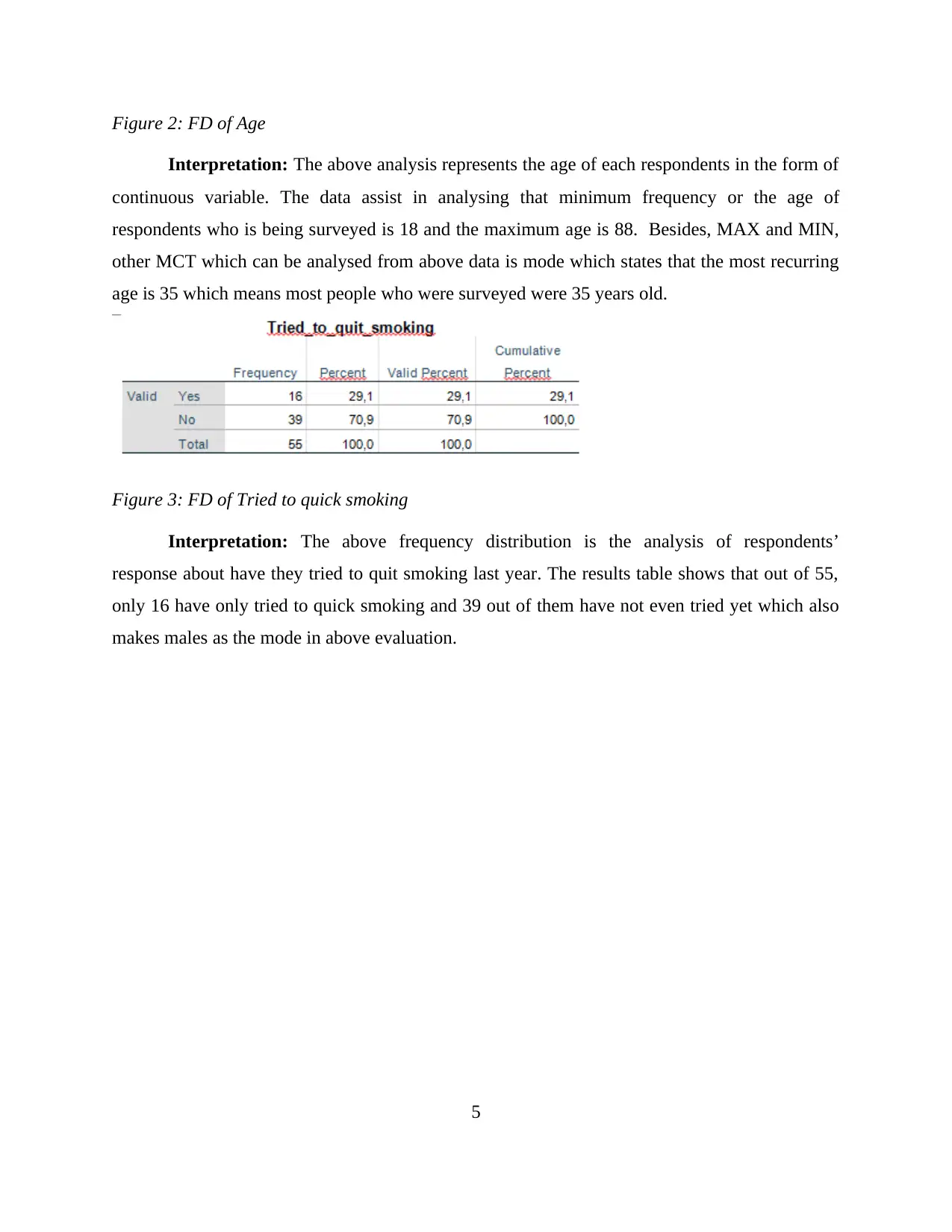
Figure 2: FD of Age
Interpretation: The above analysis represents the age of each respondents in the form of
continuous variable. The data assist in analysing that minimum frequency or the age of
respondents who is being surveyed is 18 and the maximum age is 88. Besides, MAX and MIN,
other MCT which can be analysed from above data is mode which states that the most recurring
age is 35 which means most people who were surveyed were 35 years old.
Figure 3: FD of Tried to quick smoking
Interpretation: The above frequency distribution is the analysis of respondents’
response about have they tried to quit smoking last year. The results table shows that out of 55,
only 16 have only tried to quick smoking and 39 out of them have not even tried yet which also
makes males as the mode in above evaluation.
5
Interpretation: The above analysis represents the age of each respondents in the form of
continuous variable. The data assist in analysing that minimum frequency or the age of
respondents who is being surveyed is 18 and the maximum age is 88. Besides, MAX and MIN,
other MCT which can be analysed from above data is mode which states that the most recurring
age is 35 which means most people who were surveyed were 35 years old.
Figure 3: FD of Tried to quick smoking
Interpretation: The above frequency distribution is the analysis of respondents’
response about have they tried to quit smoking last year. The results table shows that out of 55,
only 16 have only tried to quick smoking and 39 out of them have not even tried yet which also
makes males as the mode in above evaluation.
5
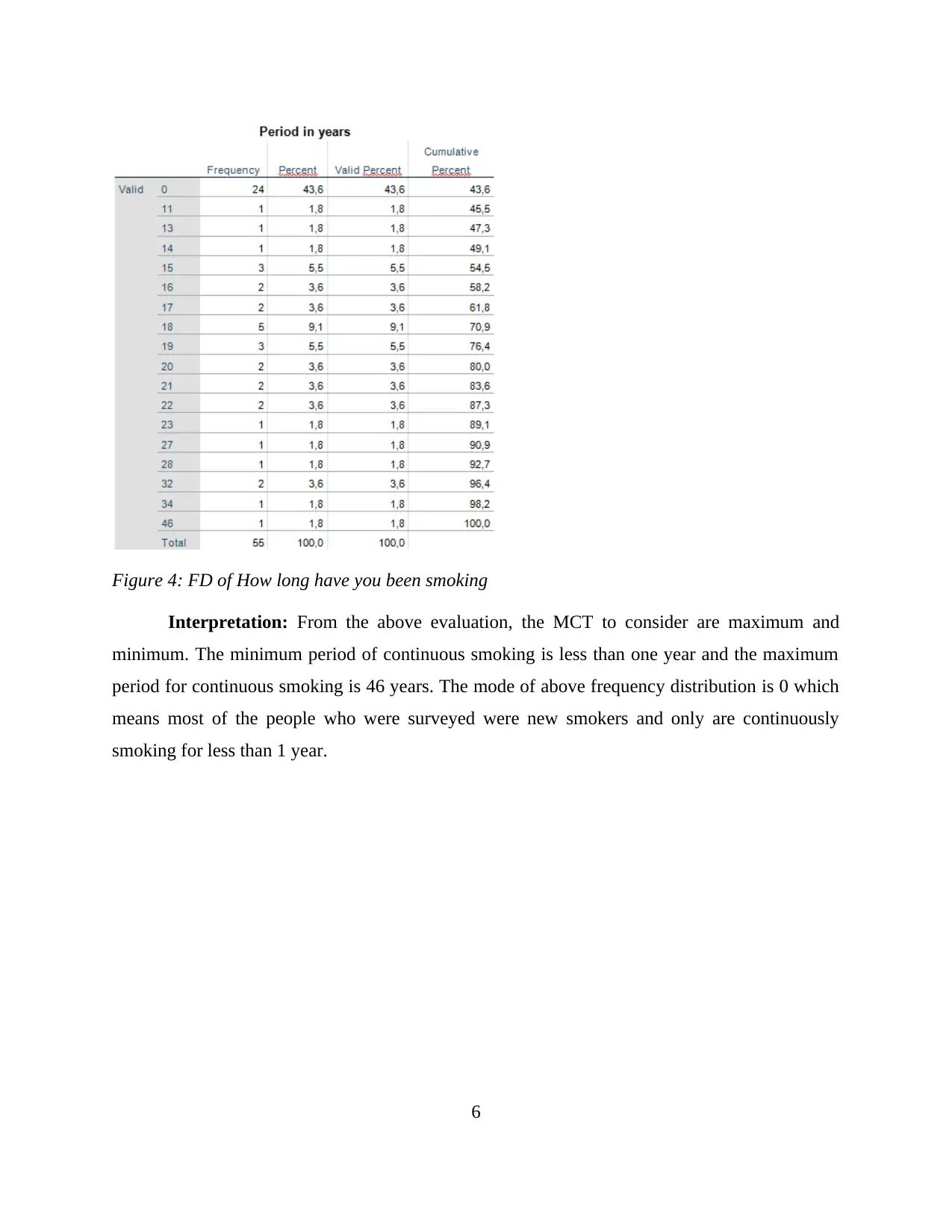
Figure 4: FD of How long have you been smoking
Interpretation: From the above evaluation, the MCT to consider are maximum and
minimum. The minimum period of continuous smoking is less than one year and the maximum
period for continuous smoking is 46 years. The mode of above frequency distribution is 0 which
means most of the people who were surveyed were new smokers and only are continuously
smoking for less than 1 year.
6
Interpretation: From the above evaluation, the MCT to consider are maximum and
minimum. The minimum period of continuous smoking is less than one year and the maximum
period for continuous smoking is 46 years. The mode of above frequency distribution is 0 which
means most of the people who were surveyed were new smokers and only are continuously
smoking for less than 1 year.
6
⊘ This is a preview!⊘
Do you want full access?
Subscribe today to unlock all pages.

Trusted by 1+ million students worldwide
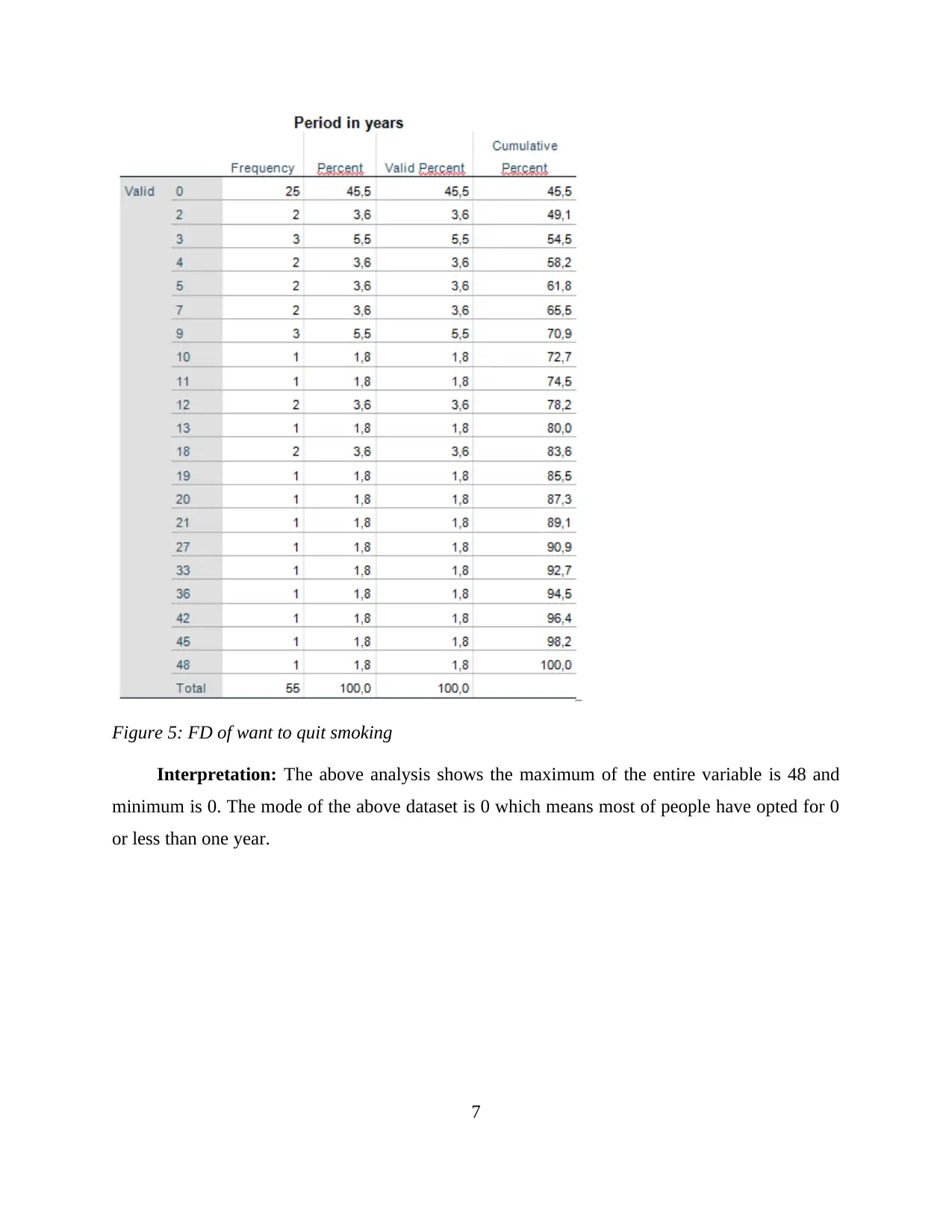
Figure 5: FD of want to quit smoking
Interpretation: The above analysis shows the maximum of the entire variable is 48 and
minimum is 0. The mode of the above dataset is 0 which means most of people have opted for 0
or less than one year.
7
Interpretation: The above analysis shows the maximum of the entire variable is 48 and
minimum is 0. The mode of the above dataset is 0 which means most of people have opted for 0
or less than one year.
7
Paraphrase This Document
Need a fresh take? Get an instant paraphrase of this document with our AI Paraphraser
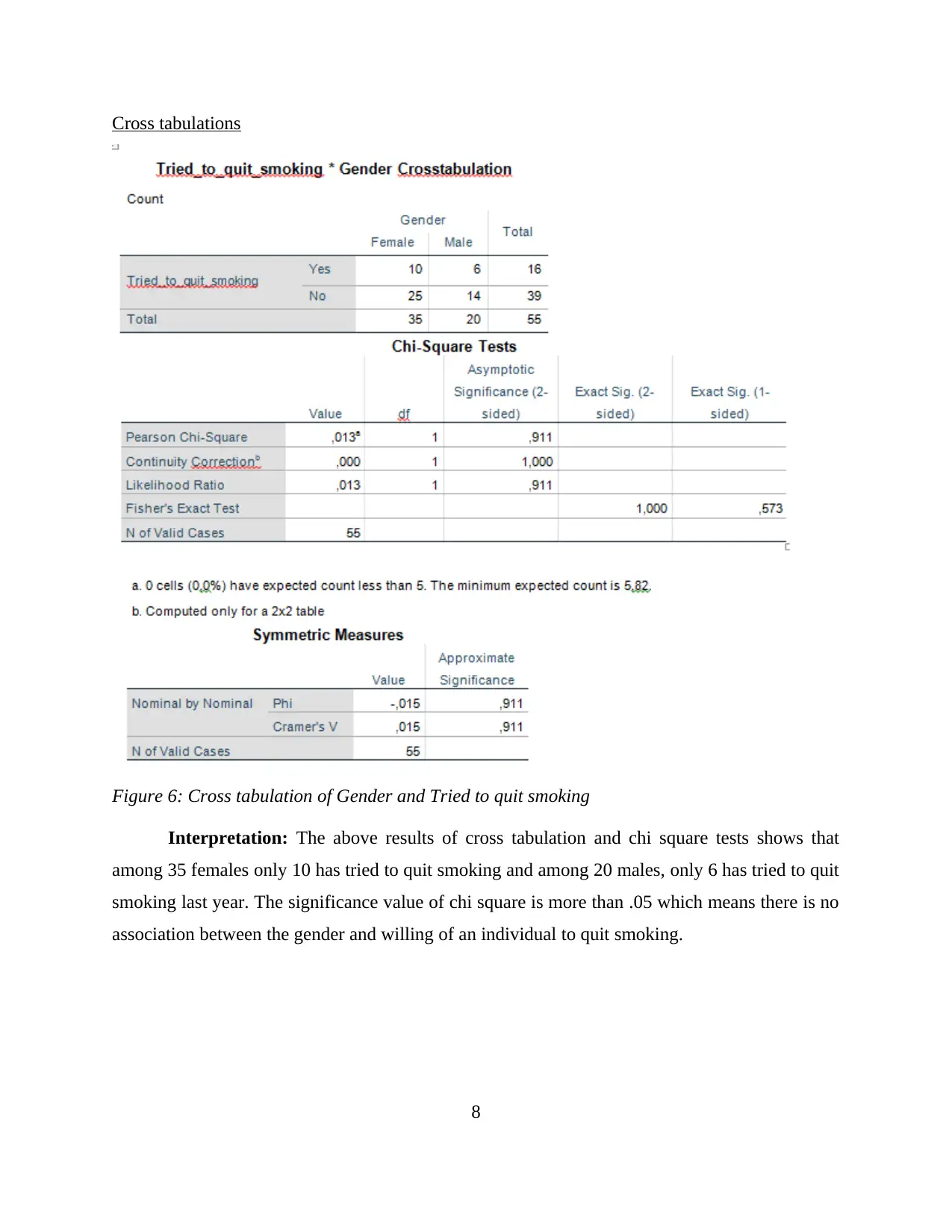
Cross tabulations
Figure 6: Cross tabulation of Gender and Tried to quit smoking
Interpretation: The above results of cross tabulation and chi square tests shows that
among 35 females only 10 has tried to quit smoking and among 20 males, only 6 has tried to quit
smoking last year. The significance value of chi square is more than .05 which means there is no
association between the gender and willing of an individual to quit smoking.
8
Figure 6: Cross tabulation of Gender and Tried to quit smoking
Interpretation: The above results of cross tabulation and chi square tests shows that
among 35 females only 10 has tried to quit smoking and among 20 males, only 6 has tried to quit
smoking last year. The significance value of chi square is more than .05 which means there is no
association between the gender and willing of an individual to quit smoking.
8
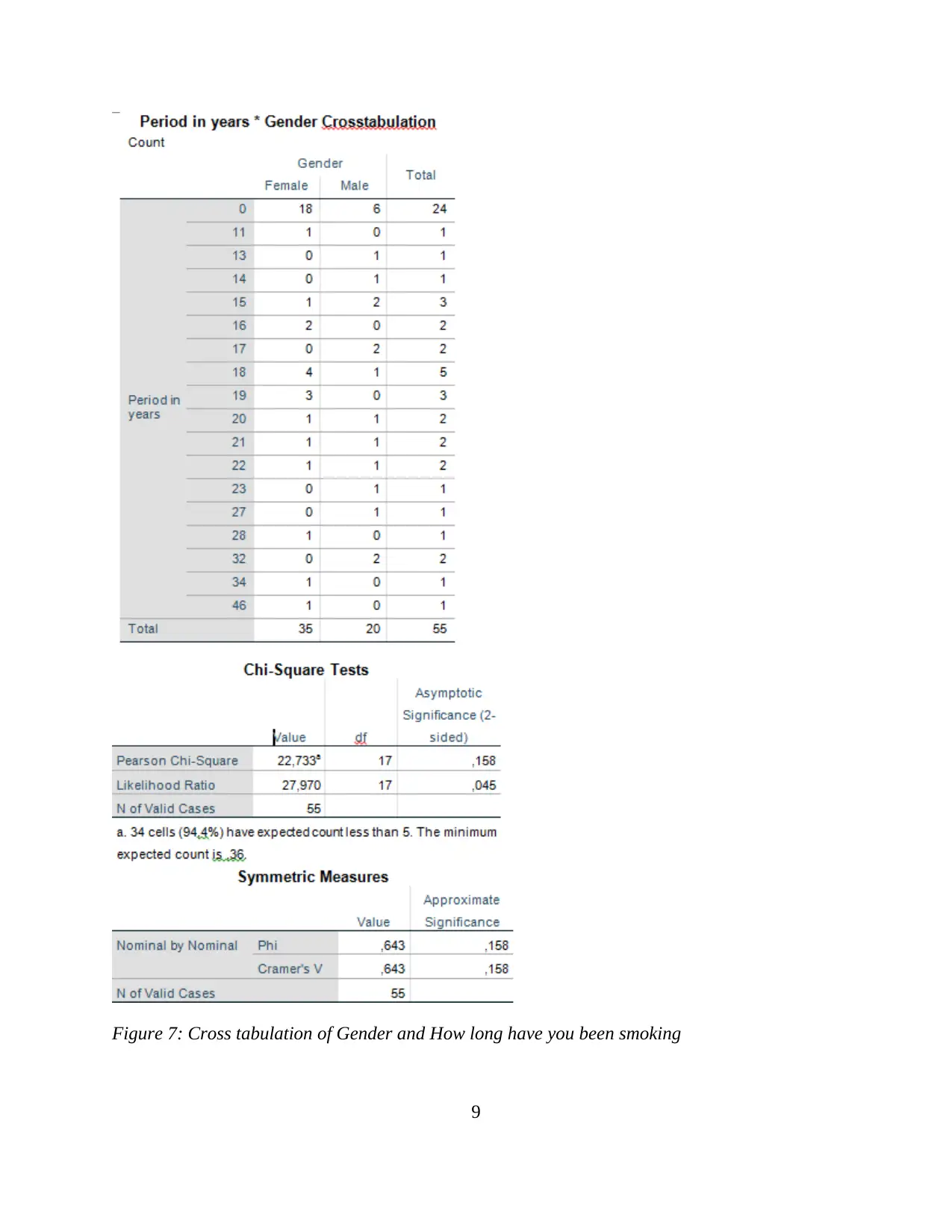
Figure 7: Cross tabulation of Gender and How long have you been smoking
9
9
⊘ This is a preview!⊘
Do you want full access?
Subscribe today to unlock all pages.

Trusted by 1+ million students worldwide
1 out of 18
Related Documents
Your All-in-One AI-Powered Toolkit for Academic Success.
+13062052269
info@desklib.com
Available 24*7 on WhatsApp / Email
![[object Object]](/_next/static/media/star-bottom.7253800d.svg)
Unlock your academic potential
Copyright © 2020–2025 A2Z Services. All Rights Reserved. Developed and managed by ZUCOL.





